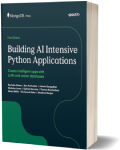Building AI-Intensive Python Applications
Artificial Intelligence
Book Details
Book Title
Building AI-Intensive Python Applications
Author
Rachelle Palmer, Ben Perlmutter, Ashwin Gangadhar, Nicholas Larew, Sigfrido Narváez, Thomas Rueckstiess, Henry Weller, Richmo
Publisher
Packt Publishing Pvt. Ltd
Publication Date
2024
ISBN
9781835886762
Number of Pages
288
Language
English
Format
File Size
8.68MB
Subject
Artificial Intelligence
Table of Contents
- Preface
- Chapter 1: Getting Started with Generative AI
- Technical requirements
- Defining the terminology
- The generative AI stack
- Important features of generative AI
- Summary
- Chapter 2: Building Blocks of Intelligent Applications
- Technical requirements
- Defining intelligent applications
- LLMs – reasoning engines for intelligent apps
- Embedding models and vector databases – semantic long-term memory
- Your (soon-to-be) intelligent app
- Summary
- Part 1: Foundations of AI: LLMs, Embedding Models, Vector Databases, and Application Design
- Chapter 3: Large Language Models
- Technical requirements
- Probabilistic framework
- Machine learning for language modelling
- ANNs for natural language processing
- Dealing with sequential data
- LLMs in practice
- Summary
- Chapter 4: Embedding Models
- Technical requirements
- What is an embedding model?
- Choosing embedding models
- Best practices
- Summary
- Chapter 5: Vector Databases
- Technical requirements
- What is a vector embedding?
- Graph connectivity
- The need for vector databases
- Case studies and real-world applications
- Vector search best practices
- Summary
- Chapter 6: AI/ML Application Design
- Technical requirements
- Data modeling
- Data storage
- Data flow
- Freshness and retention
- Security and RBAC
- Best practices for AI/ML application design
- Summary
- Part 2: Building Your Python Application: Frameworks, Libraries, APIs, and Vector Search
- Chapter 7: Useful Frameworks, Libraries, and APIs
- Technical requirements
- Python for AI/ML
- AI/ML frameworks
- Key Python libraries
- AI/ML APIs
- Summary
- Chapter 8: Implementing Vector Search in AI Applications
- Technical requirements
- Information retrieval with MongoDB Atlas Vector Search
- Building RAG architecture systems
- Summary
- Part 3: Optimizing AI Applications: Scaling, Fine-Tuning, Troubleshooting, Monitoring, and Analytics
- Chapter 9: LLM Output Evaluation
- Technical requirements
- What is LLM evaluation?
- Model benchmarking
- Evaluation metrics
- Summary
- Chapter 10: Refining the Semantic Data Model to Improve Accuracy
- Technical requirements
- Embeddings
- Embedding metadata
- Optimizing retrieval-augmented generation
- Summary
- Chapter 11: Common Failures of Generative AI
- Technical requirements
- Hallucinations
- Sycophancy
- Data leakage
- Cost
- Performance issues in generative AI applications
- Summary
- Chapter 12: Correcting and Optimizing Your Generative AI Application
- Technical requirements
- Baselining
- Testing and red teaming
- Information post-processing
- Other remedies
- Summary
- Appendix: Further Reading
- Index
- Other Books You May Enjoy
